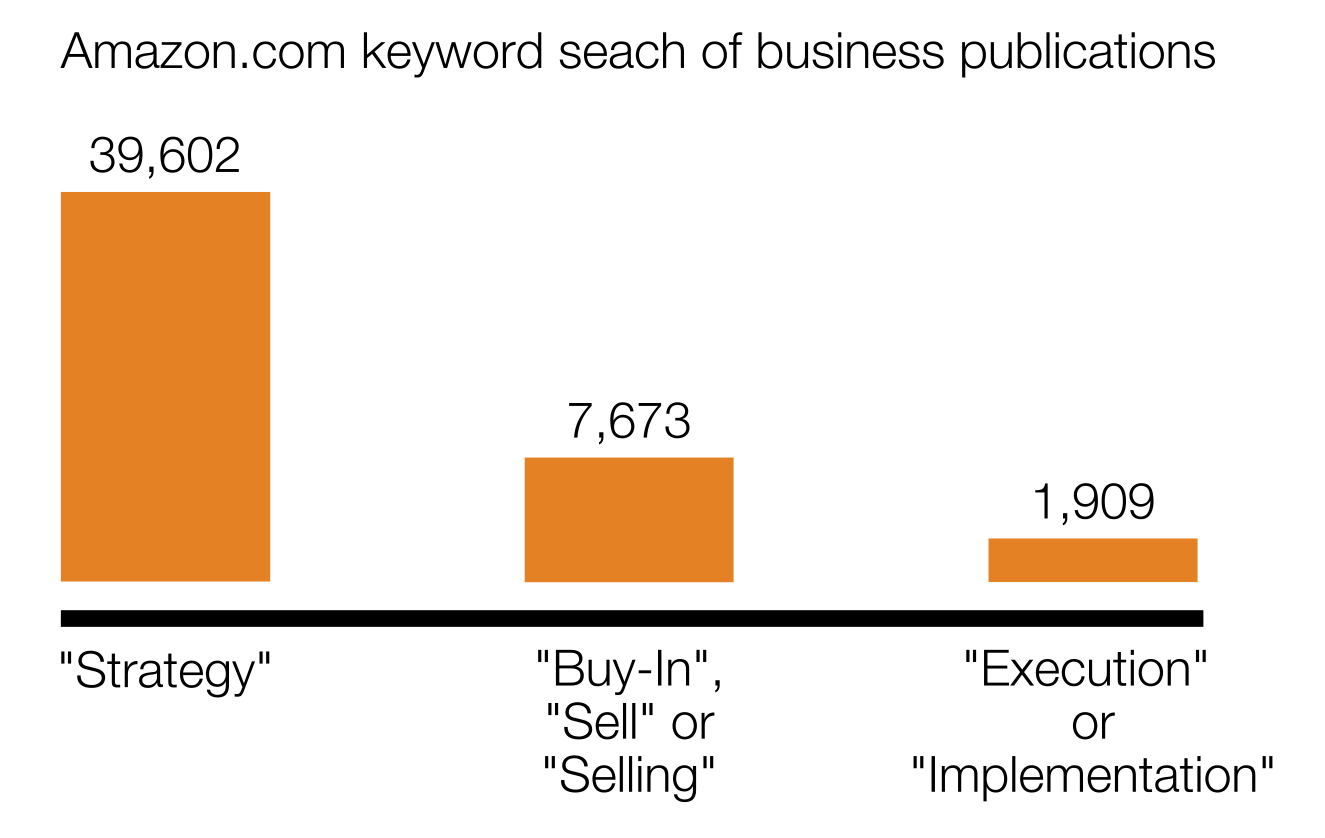In our experience, most organizations love putting together a great strategy. But when it comes to buy-in and execution, they don’t put in the same amount of effort, especially when it comes to getting important stakeholders on board. This explains why the change management community estimates that at least 70%-85% of major projects do not meet their stated goals.
To understand this better we did a search of keywords in business books on Amazon. The results are eye-opening. The number of results returned for books on strategy outnumbered those for selling and execution by a margin of 15 to 1.
It's no surprise then that we get super-excited about coming up with the best possible solution (i.e. our friend “the strategy”) and put a lot of effort into brainstorming great ideas. But when it comes to selling the ideas we forget to get the right people involved early to co-own and therefore support the plan so we start and stop. Meanwhile, time ticks on and by then we are so tired and frustrated it’s hard to keep momentum going.
We have developed a model to simulate this – it is called the Results Equation.
R = I x D x E
On the left side is “R” – our goal = sustained improved results.
To estimate the kind of results from a project you can:
- multiply I – where I equals the quality of the strategic idea
- By D which is the level of desire or buy-in of stakeholders
- By E which is the ability of the organization to execute.
-
Let’s see how it works using an example.
Let’s say in this case “we’ve got a superb improvement idea that will revolutionize our work” – we’ll give that a “I” or Idea score of 100%.
Desire or Buy-In. Well, we don’t really have everyone on board so at best let’s give that measure 50%.
As for Execution, in the past, sometimes we get this right, sometimes we don’t so 50% sounds about right.
100% X 50% X 50% = 25%
Do the math and you’re left with a 25% Results score… if we’re looking for 100% (a perfect score) we are falling well short. If we can find ways to bump up the low scores, in this example Desire and Execution – we may be able to increase our chances of success and get a better result.
The important point here is that while the quality of the Idea is important, a lower score for Desire, or for Execution, have just as heavy an impact on Results as the quality of the Idea.
There is so much literature on how to do a proper analysis and generate great ideas so let's focus first on how to increase your Desire score.
Increasing Your DESIRE Score:
Some common reasons why Desire/Buy-In is low, and what you can do about them:
Increasing Your EXECUTION Score:
Some common reasons why Execution is low, and what you can do about them:
- Overcome the "Cost of Hesitation" by building your project to secure quick wins and momentum, so it is implemented before things change. Faster projects don’t encounter as many changes as slow projects.
- Include in your project team meetings the questions: “Since our last meeting: What Went Well (WWW); What Didn’t go Well (WDW); and What should we Do Differently (WDD)?”. Making these questions part of your project routine will allow you to change with changes in environment and not get too far out of line.
In this content area, we cover:
- Increasing buy-in to your initiative by:
- Creating a compelling elevator pitch, using visuals and surprising facts
- Using the power of Natural Attractors
- Harnessing the energy of first followers/influencers
- Working with executives and leaders
- Building trust
- Influence without authority
- Dealing with objections
- Changing mindsets
- Improving execution/implementation of your initiative by:
- Creating focus and reducing multi-tasking
- Project sequencing
- Estimating and budgeting effort required
- Definition of “Done”
- Using visual management to create momentum
- Retrospectives
- Making it easy to use the new way, making it hard to use the old way, and making it rewarding to use the new way.
- Creating a buy-in and execution plan for your own initiative



